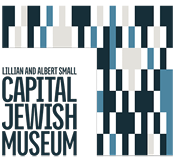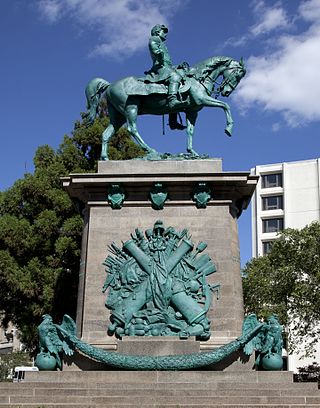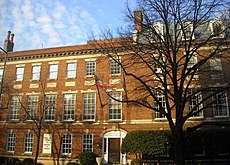History
Jewish War Veterans National Commander Paul Ginsberg urged JWV leaders gathered at the October 1951 National Executive Committee meeting to move JWV's headquarters from New York to Washington, DC, and suggested the new headquarters building include a shrine or memorial to Jewish American veterans. The memorial was envisioned as a repository for records and memorabilia relating to Jewish service in the American military, in addition to being a living memorial to the patriotism of American Jews. In 1954 the Jewish War Veterans purchased a building at 1712 New Hampshire Ave NW in Washington, DC. Along with moving their headquarters to this building the JWV also established the National Shrine to the Jewish War Dead.
On 2 September 1958, following the granting of a congressional charter, the Shrine became known as the Jewish War Veterans of the USA National Memorial, Inc. The museum's charter is registered as Public Law 85-3, HR 109. The museum and JWV relocated a final time in 1983, following the purchase of a building at 1811 R Street NW. The building was officially dedicated in 1984 by then Vice President George H.W. Bush.
Combating anti-Semitism, particularly charges that Jews are somehow less patriotic than other Americans, continues to be a goal of both the JWV and the NMAJMH. The museum – through its exhibitions, archives, and programs – documents of the long history of honorable and distinguished service of Jews in the American military from the Revolutionary War to the present.

The National Mall is a landscaped park near the downtown area of Washington, D.C., the capital city of the United States. It contains and borders a number of museums of the Smithsonian Institution, art galleries, cultural institutions, and various memorials, sculptures, and statues. It is administered by the National Park Service (NPS) of the United States Department of the Interior as part of the National Mall and Memorial Parks unit of the National Park System. The park receives approximately 24 million visitors each year.

Dupont Circle is a historic roundabout park and neighborhood of Washington, D.C., located in Northwest D.C. The Dupont Circle neighborhood is bounded approximately by 16th Street NW to the east, 22nd Street NW to the west, M Street NW to the south, and Florida Avenue NW to the north. Much of the neighborhood is listed on the National Register of Historic Places. However, the local government Advisory Neighborhood Commission and the Dupont Circle Historic District have slightly different boundaries.

The National Building Museum is a museum of architecture, design, engineering, construction, and urban planning in Washington, D.C., United States. It was created by an Act of Congress in 1980, and is a private non-profit institution. Located at 401 F Street NW, it is adjacent to the National Law Enforcement Officers Memorial and the Judiciary Square Metro station. The museum hosts various temporary exhibits in galleries around the spacious Great Hall.

The United States Holocaust Memorial Museum (USHMM) is the United States' official memorial to the Holocaust. Adjacent to the National Mall in Washington, D.C., the USHMM provides for the documentation, study, and interpretation of Holocaust history. It is dedicated to helping leaders and citizens of the world confront hatred, prevent genocide, promote human dignity, and strengthen democracy.

There are many outdoor sculptures in Washington, D.C. In addition to the capital's most famous monuments and memorials, many figures recognized as national heroes have been posthumously awarded with his or her own statue in a park or public square. Some figures appear on several statues: Abraham Lincoln, for example, has at least three likenesses, including those at the Lincoln Memorial, in Lincoln Park, and the old Superior Court of the District of Columbia. A number of international figures, such as Mohandas Gandhi, have also been immortalized with statues. The Statue of Freedom is a 19½-foot tall allegorical statue that rests atop the United States Capitol dome.

The United States Navy Memorial is a memorial in Washington, D.C. honoring those who have served or are currently serving in the Navy, Marine Corps, Coast Guard, and the Merchant Marine.

Waddy Butler Wood was an American architect of the early 20th century and resident of Washington, D.C. Although Wood designed and remodeled numerous private residences, his reputation rested primarily on his larger commissions, such as banks, commercial offices, and government buildings. His most notable works include the Woodrow Wilson House and the Main Interior Building.

Sheridan Circle is a traffic circle and park in the Sheridan-Kalorama neighborhood of Washington, D.C. The traffic circle, one of two in the neighborhood, is the intersection of 23rd Street NW, Massachusetts Avenue NW, and R Street NW. The buildings along this stretch of Massachusetts Avenue NW are part of Embassy Row, which runs from Scott Circle to Observatory Circle. Sheridan Circle is a contributing property to the Massachusetts Avenue Historic District and the Sheridan-Kalorama Historic District, both listed on the National Register of Historic Places (NRHP). In addition, the equestrian statue of General Philip Sheridan is 1 of 18 Civil War Monuments in Washington, D.C., that were collectively listed on the NRHP.

Jewish War Veterans of the United States of America is an American Jewish veterans' organization created in 1896 by American Civil War veterans to raise awareness of contributions made by Jewish service members.

The Capital Jewish Museum, officially the Lillian & Albert Small Capital Jewish Museum, is a historical society and museum in Washington, D.C., focused on the history of Jewish life in the American capital city and the surrounding Washington metropolitan area.

The following outline is provided as an overview of and topical guide to District of Columbia:

The Edlavitch Jewish Community Center of Washington, D.C. is a Jewish Community Center located in the historic district of Dupont Circle. It serves the Washington, D.C. area through religious, cultural, educational, social, and sport center programs open to the public, although many programs are strongly linked to Jewish culture, both in the United States and in Israel. It is part of the JCC Association (JCCA), the umbrella organization for the Jewish Community Center movement, which includes more than 350 JCCs, YM-YWHAs, and camp sites in the U.S. and Canada, in addition to 180 local JCCs in the Former Soviet Union, 70 in Latin America, 50 in Europe, and close to 500 smaller centers in Israel.

General Philip Sheridan is a bronze sculpture that honors Civil War general Philip Sheridan. The monument was sculpted by Gutzon Borglum, best known for his design of Mount Rushmore. Dedicated in 1908, dignitaries in attendance at the unveiling ceremony included President Theodore Roosevelt, members of the President's cabinet, high-ranking military officers and veterans from the Civil War and Spanish–American War. The equestrian statue is located in the center of Sheridan Circle in the Sheridan-Kalorama neighborhood of Washington, D.C. The bronze statue, surrounded by a plaza and park, is one of eighteen Civil War monuments in Washington, D.C., which were collectively listed on the National Register of Historic Places in 1978. The sculpture and surrounding park are owned and maintained by the National Park Service, a federal agency of the Interior Department.

Jewish Americans have served in the United States armed forces dating back to before the colonial era, when Jews had served in militias of the Thirteen Colonies. Jewish military personnel have served in all branches of the armed forces and in every major armed conflict to which the United States has been involved. According to the U.S. Department of Defense, as of 2006 there were currently 3,973 known Jewish servicemen and servicewomen on active duty.
The American Jewish Military Heritage Project is an internet educational project sponsored by the National Museum of American Jewish Military History, providing links to websites, films, and literature documenting the contributions of Jews to the American military or sites of interest to Jewish American veterans.

Major General George B. McClellan is an equestrian statue in Washington, D.C. that honors politician and Civil War general George B. McClellan. The monument is sited on a prominent location in the Kalorama Triangle neighborhood due to efforts made by area residents. The statue was sculpted by American artist Frederick William MacMonnies, a graduate of the École des Beaux-Arts whose best known work is a statue of Nathan Hale in New York City. MacMonnies was chosen to design the statue following a lengthy competition organized by a statue commission, led by then Secretary of War William Howard Taft. The monument was dedicated in 1907, with prominent attendees at the ceremony including President Theodore Roosevelt, New York City mayor George B. McClellan Jr., politicians, generals and thousands of military personnel.

Whittemore House is an historic building located at 1526 New Hampshire Avenue, N.W., in the Dupont Circle neighborhood of Washington, D.C. The former private residence, whose previous occupants include a musician, several politicians, and a mountain explorer, now serves as a historic house museum and headquarters of the Woman's National Democratic Club (WNDC).

Appleton Prentiss Clark Jr. was an American architect from Washington, D.C. During his 60-year career, Clark was responsible for designing hundreds of buildings in the Washington area, including homes, hotels, churches, apartments and commercial properties. He is considered one of the city's most prominent and influential architects from the late 19th and early 20th centuries. Many of his designs are now listed on the National Register of Historic Places (NRHP).

The Sheridan-Kalorama Historic District is a neighborhood and historic district located in the northwest quadrant of Washington, D.C. The boundaries of the historic district include Rock Creek Park to the north and west, P Street to the south, and 22nd Street and Florida Avenue to the east. On the southwestern edge of the neighborhood is a stretch of Embassy Row on Massachusetts Avenue. The other neighborhood and historic district that lies to the east of Sheridan-Kalorama is Kalorama Triangle Historic District. The two neighborhoods are divided by Connecticut Avenue. For many years both neighborhoods were geographically connected before the stretch of Connecticut Avenue was installed towards the Taft Bridge. Often times, both neighborhoods are simply called "Kalorama" or "Kalorama Heights".
The history of the Jews in Washington, D.C. dates back to the late 18th century and continues today. From only individual Jews settling in the city to the waves of Jewish migration in the 1840s, during the American Civil War, and in the late 19th century to the early 20th century and beyond, the community has steadily grown.





















